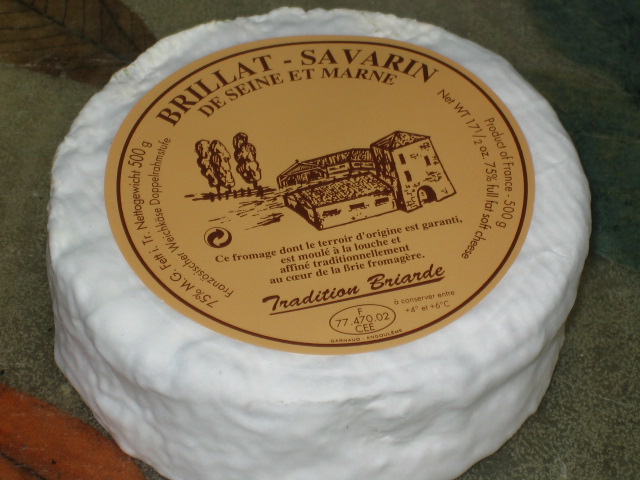
Nothing goes better with good times and sparkling wine than Triple Crème cheeses!
(From Formaggio Kitchen, a Boston-based cheese shop): “The terms “double-crème” and “triple-crème” are bandied about a lot in cheese shops. While most folks have a general idea of what they mean in terms of texture (creamy, spreadable!) and flavor (buttery, lactic!) for a cheese, these terms actually have very specific meanings.
Both double and triple-crème cheeses have extra cream added before the curd is formed. And, at least according to French law, a double-crème cheese has between 60-75% butterfat. Cheeses that fall into this category are, for example, Brie and Camembert. The first ever double-crème cheese was made in Normandy in 1850 and was called Petit Suisse. According to Steve Jenkins’ Cheese Primer, the name of the cheesemaker is lost to history – all we know is that, per the name of the cheese, he was a small fellow of Swiss extraction!
Triple-crème cheeses made an appearance roughly 75 years after Petit Suisse was introduced. These uber-creamy cheeses also found their origins in Normandy. Made by the Dubuc family, the first triple-crème was called Le Magnum and is the ancestor of today’s Brillat-Savarin.
All triple-crème cheeses are required to have a butterfat content of 75% or more. When people hear fat levels of 60% or 75% being discussed, they occasionally blanch. And, yes, these cheeses have added cream but the lingo can also be a little bit misleading (at least it was to me at first).
When folks in cheese talk about fat levels, they are usually talking about the percentage of fat in the dry matter of the cheese. Double and triple-crème cheeses are in most cases fairly young and have high levels of moisture – they can still be comprised of something in the region of 50% water.
As such, when one talks about a cheese with 70% butterfat, you are saying that of the dry matter in a cheese (or roughly 50% of the cheese), 70% of THAT is butterfat. So, for example, the Brie that we generally have in the shop contains 60% butterfat but if you take the cheese as a whole (i.e. including the water content), 31% of it is fat. Similarly, our Brillat-Savarin has “75% fat in dry matter” and “39% total fat.”
As a point of reference, butter generally contains between 80-86% total fat (80% is the legal minimum for butter in the US).
You may wonder why those in the cheese world talk about fat in dry matter (FDM) as opposed to the overall fat content. Turns out, the former is a more consistent benchmark both for cheese makers and regulators. For example, wheels of Parmigiano Reggiano have broadly similar moisture levels of roughly 30%. However, there will be some variation among wheels from different producers and between wheels of different ages (as cheeses age, they tend to lose moisture). In contrast, the dry matter of a cheese is not going anywhere (that is, unless you start eating it). So, when the Parmigiano Reggiano consortium stipulates (among other criteria) that in order to be the real deal, parm has to have a minimum of 32% FDM, that is something that can be measured consistently.
Think about density too – if you are looking at a cheese like Parmigiano Reggiano, Cabot Clothbound Cheddar or Gouda, there is a lot more “dry matter” packed into every square inch of that cheese than in younger, moister, spreadable cheeses like Brie or Brillat-Savarin. So, for every cubic inch of parm that you eat, despite the fact that it is partially made with skim milk, you are ingesting more dry matter than you would with a square inch of Brie. Harder cheeses like parm tend to have more protein than the soft spreadable cheeses, so not all of that extra matter in your mouth is fat (on average, parm is 30% moisture, 33% protein and 28% total fat).
For similar reasons, this is why when someone asks for a 1/2-pound of parm, they get a smaller piece of cheese than if they ask for a 1/2-pound of Brie. Because each square inch of the parm holds more matter, it is denser and therefore heavier on a volume basis. One square inch of parm will weigh more than one square inch of Brie. Phew!
Ok, enough math now and on to tastier subjects like what to serve with double and triple-crème cheeses. Champagne or something bubbly is classic, particularly with the triple-crèmes. Pairing these cheeses with fresh fruits – like raspberries, mango or strawberries – is also strongly recommended. If you think about the classic Wimbledon trifecta – champagne, strawberries and cream – successful pairings for creamy cheeses tend to follow a similar pattern. With Brie and other double-crème cheeses, fresh grapes are a frequent go-to, as are raisins. “


